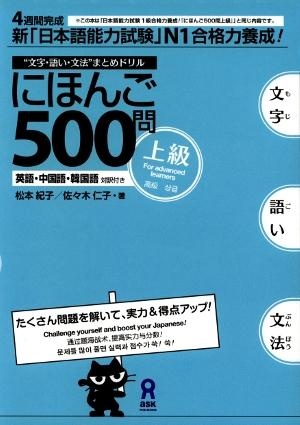The Nihongo 500 series of books has been created according to the Japanese Language Proficiency Test (JLPT) levels with N5 being for beginners and N1 for upper advanced students. There are three books altogether with the first book covering N5 and N4, the second book N3 and N2, and the final book is just for the N1 level. Each book aims to teach grammar, vocabulary and kanji within a well-structured week by week learning method. Although it is broadly aimed at students studying for the JLPT exam it is actually very useful for anyone who wishes to improve their reading skills and expand their vocabulary and grammar.
Although this is an advanced book the answer key for each question includes English, Chinese and Korean translations as well as a breakdown of some difficult kanji and some extra sentences to help demonstrate how to use a particular piece of grammar. The content page shows how the book is divided into four weeks with a kanji list, vocabulary list and grammar list at the end. There is a small introduction explaining how to use the book, it is recommended to just study 20 minutes a day to complete each day’s workload of 5 pages for 6 days. On the 7th day there is a review section, although the authors do ask that you don’t undertake this unless you answered correctly most of the previous 6 day’s questions. If you follow this plan successfully then the goal is to complete the whole book in four weeks.
.JPG)
The exercises for each day consist of 5 pages with three types of question on each page, one type is for kanji. There is a sentence with either one or two kanji words underlined, or instead of kanji the word is written in hiragana, underneath there are four options of either hiragana or kanji depending on the underlined words and the object is to be able to select the correct option. The second question is a vocabulary question, there is a sentence with a blank space and it is necessary to pick the correct word from the four options given. The third question is for grammar, again there is a sentence with a blank space and from the four options the student needs to pick the grammatically correct option for the blank space.
On the following page there is the answer key, this provides the translation of the sentence as well as the correct answer. In addition for the kanji question there is a further explanation of the meaning of the more difficult kanji characters along with their different meanings. The answer key for the vocabulary question also provides translations of the three incorrect options to help expand the student’s vocabulary. The answer for the grammar question also provides a simplified explanation of the grammar as well as some sample sentences.
This book is for self-study; however how you use it is up to you. For someone with a busy life it is too easy to miss a day, and then two days, etc. If you are a diligent student then perhaps it is possible to do the 20 minutes every day, however this is probably asking too much. As such although the whole idea of needing to just study a little bit every day for four weeks is really nice, and sounds very easy, in practice it is extremely hard to do. It might be better to market this book more towards language school or university courses and turn it into more of a homework book. In this way the teacher could set 5 pages as homework each day, or more for a weekly class, and this would be a good motivational way of getting students to actually complete the entire book.
"Another good factor is that many of the sentences in this book can be found in daily life, if you live in Japan, such as advertisements, public messages, and even little snippets from business conversation."
For an advanced level student this is a very good book to study, if you have enough free time and are motivated then certainly it is possible to finish in four weeks; however it is also a good book to use just whenever you have free time. Although it is marketed for self-study the fact is that it’s very difficult to keep up the daily pace, but the amount of grammar, vocabulary, etc, that you can learn is very useful. Another good factor is that many of the sentences in this book can be found in daily life, if you live in Japan, such as advertisements, public messages, and even little snippets from business conversation. In this way your learning is reinforced by actually being able to read or hear these same sentences in normal life, however if you don’t live in Japan then much of the book might sound quite random or irrelevant.
Overall it is worth using to improve Japanese knowledge, however someone studying Japanese full time or actually living in Japan would probably gain a lot more from it.



